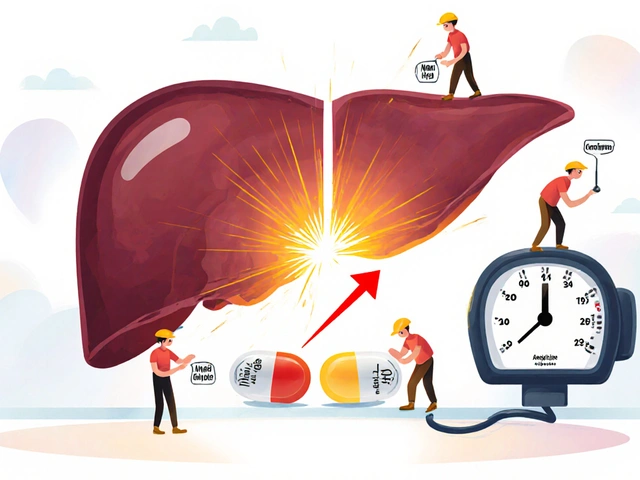
Switching from a branded respiratory inhaler to a generic version might seem like a simple cost-saving move-but for many patients, it’s anything but. Unlike pills, where swapping a generic for a brand-name drug usually works without issue, respiratory combination inhalers involve complex devices that affect how the medicine reaches your lungs. Get the device wrong, and you might not get the medicine at all.
Why Inhalers Are Different
Most people think of generics as cheaper versions of the same drug. That’s true for tablets. But with inhalers, the device isn’t just packaging-it’s part of the medicine. Two inhalers can contain identical amounts of budesonide and formoterol, yet deliver them completely differently. One might need a slow, deep breath. Another requires a sharp, forceful inhale. If you’re used to one and switch to another without training, you’re essentially taking a different dose. A 2020 study found that 76% of patients switched from a Turbuhaler to a Spiromax without proper instruction used it incorrectly. That’s not a small mistake. It means their asthma or COPD wasn’t being controlled. And when your lungs aren’t getting the medicine, flare-ups follow. Some patients end up in the ER.Device Differences You Can’t Ignore
There are three main types of inhalers: pressurized metered-dose (pMDI), dry powder (DPI), and nebulizers. Most combination inhalers today are DPIs. But even within DPIs, the mechanics vary wildly. Take the Turbuhaler and Spiromax. Both contain budesonide and formoterol. But the Turbuhaler requires you to twist the base to load a dose. The Spiromax uses a side slider. One needs a steady breath. The other demands a quick, strong inhale. The priming steps are different. The way you hold them is different. If you’ve been using a Turbuhaler for years and your pharmacy hands you a Spiromax without a word, you’re flying blind. A 2021 study in the Journal of Aerosol Medicine and Pulmonary Drug Delivery showed patients switched without training had a 22% increase in asthma attacks within six months. That’s not a coincidence. That’s a direct result of improper technique.Regulations Vary by Country
In the U.S., the FDA says generic inhalers should be interchangeable without extra training. They approve them based on bioequivalence data-how much drug enters the bloodstream. But that doesn’t tell you how much reaches your lungs. In Europe, the EMA takes a harder line. They require proof that the generic works just as well in the lungs-not just in the blood. That means more testing. Fewer generics get approved. And when they do, the agency insists on clear labeling and patient education. The UK’s NICE guidelines are blunt: switching inhaler devices without consultation can worsen asthma control. They don’t just recommend caution-they warn against automatic substitution. And it’s not just policy. Real people are paying the price. On Reddit’s asthma community, 83% of patients who were switched to a generic without warning reported worse symptoms. A 2022 survey by Asthma UK found that 57% of patients felt confused after a switch. One in three had an emergency visit within three months.
What Patients Are Saying
Patient reviews tell the real story. Symbicort Turbohaler has a 6.2 out of 10 rating from over 1,000 users. DuoResp Spiromax, the generic alternative, sits at 4.8 out of 10. The complaints are consistent: “Harder to use,” “Feels less effective,” “I didn’t know I had to breathe in harder.” One patient wrote in the Pharmaceutical Journal: “When my pharmacy switched me to the Spiromax without telling me, I didn’t realize I needed to breathe in harder, and my asthma got so bad I ended up in hospital.” But it’s not all bad. When patients get proper training, success rates jump. One 2022 study found that 89% of people using a generic inhaler correctly had been shown how to use it by a nurse or pharmacist. The difference isn’t the drug. It’s the instruction.Doctors and Pharmacists Are Struggling Too
Switching inhalers isn’t just a patient problem. It’s a system problem. A study from the National Institutes of Health found that general practitioners needed an average of 12.7 minutes of training just to learn how to demonstrate both Turbuhaler and Spiromax techniques correctly. Nearly half couldn’t do it right on their first try. Pharmacists are under pressure. Time is short. In the U.S., only 28% of community pharmacies consistently offer device-specific training when substituting inhalers. The top reason? Lack of time. But skipping training isn’t saving money-it’s costing more. A 2023 IMS Health report estimated that inappropriate inhaler substitution leads to $1.2 billion in avoidable ER visits and hospital stays every year in the U.S. alone. That’s more than the entire savings from switching to generics.What Should You Do?
If your doctor or pharmacist suggests switching your inhaler, ask these questions:- Is this a different device? If so, how is it different?
- Will I need to change how I use it?
- Can you show me how to use it right now?
- Can I try it before I leave?

What About the Future?
More generic inhalers are coming. By 2027, nearly half of all combination inhalers will face generic competition. The FDA is investing $25 million into research on how to make substitutions safer. The European Respiratory Society now recommends prescribing inhalers by brand name to avoid confusion. New tech is helping, too. Smart inhalers with sensors that track your technique and send feedback to your phone are becoming more common. One 2022 study showed they reduced asthma flare-ups by 33% when used during device switches. But technology won’t fix bad policy. The solution isn’t more generics. It’s better communication. Better training. Better rules.Bottom Line
Generic substitution for inhalers isn’t like swapping aspirin. It’s not a simple swap. It’s a change in how you breathe. And if you don’t know how to breathe right, the medicine won’t work. Your health isn’t a cost center. Don’t let a pharmacy decision put you at risk. Ask questions. Demand training. Make sure you know how to use your inhaler-no matter what brand or generic it is.Can I just switch to a generic inhaler without asking my doctor?
No. Generic inhalers often use different devices, even if they contain the same medicines. Switching without a consultation can lead to incorrect use, reduced effectiveness, and increased risk of asthma or COPD flare-ups. Always talk to your doctor or pharmacist before switching.
Why do some generic inhalers feel less effective?
They’re not necessarily less effective-they’re just delivered differently. A generic inhaler might require a harder or faster breath than your original. If you’re using it the same way, you’re not getting the full dose. This isn’t a drug issue-it’s a technique issue.
How can I tell if my inhaler has changed?
Check the name on the device. If it’s different from what your doctor prescribed-even if the medicine inside is the same-it’s a different device. Look at the shape, how you load the dose, and how you inhale. If it feels unfamiliar, ask your pharmacist to show you how to use it.
Is there a way to track if I’m using my inhaler correctly?
Yes. Smart inhalers with built-in sensors can track when and how you use them. They connect to apps that give feedback on your technique. Some are available by prescription. Ask your doctor if one is right for you, especially if you’ve had trouble with inhalers before.
What should I do if my symptoms get worse after switching inhalers?
Contact your doctor immediately. Don’t assume it’s just your condition getting worse. It could be that you’re not using the new inhaler correctly. Bring the device with you and ask for a technique check. You may need to switch back or get proper training before continuing.




Christopher K
November 20, 2025 AT 16:16Oh wow, so the FDA just lets pharmacies swap life-saving inhalers like they’re swapping out a pack of gum? And we wonder why people end up in the ER? This isn’t healthcare-it’s a corporate cost-cutting circus with people’s lungs as the punchline. 🤡
harenee hanapi
November 20, 2025 AT 22:03I switched to a generic last year and I swear I felt like I was breathing through a straw wrapped in duct tape. My doctor said ‘it’s the same medicine’-but my lungs didn’t get the memo. I cried in the pharmacy aisle because I couldn’t catch my breath and the pharmacist just handed me the box like it was toilet paper. I’m still scared to use it.
Christopher Robinson
November 21, 2025 AT 01:20Big love to the author for breaking this down so clearly. 🙌 Seriously, this is the kind of info people need before they get handed a new inhaler. I’ve seen friends go from stable to ER because they didn’t know the new device needed a sharp inhale. Just ask for a demo. Always. And if they say ‘it’s the same,’ ask them to demonstrate it themselves. If they can’t? Run.
James Ó Nuanáin
November 22, 2025 AT 00:09It is profoundly regrettable that the United States regulatory framework permits such a cavalier approach to therapeutic equivalence in inhaler devices. The European Medicines Agency, by contrast, insists upon demonstrable pulmonary bioequivalence-not merely systemic absorption. To permit substitution without device-specific training is not merely negligent; it is a violation of the Hippocratic Oath by proxy. The data is unequivocal: improper technique leads to increased morbidity, hospitalisation, and mortality. This is not a cost-saving measure. It is a public health failure.
Nick Lesieur
November 23, 2025 AT 07:09lol so the solution is to make every patient a respiratory therapist? i mean, sure, why not add 20 mins of inhaler bootcamp to every pharmacy visit? next they’ll make us pass a quiz on how to not die before we get our albuterol. also, who’s gonna pay for the 12.7 mins of training? the $1.2 BILLION in ER visits? yeah right. we’re all just gonna keep breathing wrong and pretending it’s fine.
Andy Feltus
November 24, 2025 AT 01:16It’s funny how we treat pills like they’re magic beans-pop one, it works. But when it’s an inhaler, suddenly we’re supposed to be engineers of airflow? We don’t teach breathing in school. We don’t train people to use medical devices. We just hand them a plastic tube and say ‘figure it out.’ And then we’re shocked when people get sicker. The real tragedy isn’t the generics-it’s that we’ve turned healthcare into a puzzle where the patient is expected to solve it alone.
river weiss
November 25, 2025 AT 21:58Let me be clear: the notion that bioequivalence in plasma concentration equals therapeutic equivalence in the lungs is not just flawed-it is dangerously simplistic. The pharmacokinetics of inhaled drugs are governed by particle size, inhalation velocity, breath-hold duration, and device geometry. These are not trivial variables. The FDA’s approval criteria for generic inhalers are archaic, inadequate, and fundamentally disconnected from clinical reality. Until regulators require pulmonary deposition studies, this will continue to be a silent epidemic. Patients deserve better than corporate convenience.
Brian Rono
November 27, 2025 AT 14:26Oh, so now we’re pretending that ‘the same drug’ means ‘the same outcome’? That’s like saying two different cars with the same engine are equally drivable. One’s a Prius, one’s a tank. You don’t drive them the same way. But hey, let’s just swap them at the dealership and blame the driver when they crash. Classic American logic: if it’s cheaper, it’s fine. Even if it kills you slowly. I’m not mad. I’m just disappointed.
seamus moginie
November 28, 2025 AT 07:37My cousin in Dublin got switched to a generic and ended up in hospital with pneumonia. They didn’t even tell her the device changed. She thought it was her asthma getting worse. Turned out she was inhaling like she was trying to suck a milkshake through a straw. The pharmacist didn’t even look up from her phone. I’m not even mad anymore. Just… numb.
Dana Dolan
November 29, 2025 AT 08:01I just switched to a new inhaler last week and didn’t realize the technique was different until I started wheezing again. I’m so glad I asked my nurse to show me again. She didn’t even blink. Just said, ‘Let’s do it together.’ I cried. Not because I was scared-because someone finally cared enough to check.
Steve and Charlie Maidment
December 1, 2025 AT 06:48So what you’re saying is, we’ve got a healthcare system that’s so broken, the only way to stay alive is to become a full-time medical device technician? And the people who are supposed to help you-doctors, pharmacists-are too overworked to even show you how to use the thing? And you’re supposed to be grateful because it’s cheaper? That’s not healthcare. That’s a dystopian customer service simulation where your lungs are the product and the customer is always wrong.
Michael Petesch
December 1, 2025 AT 14:25This raises an important cultural question: in societies where healthcare is commodified, do we lose the obligation to educate? In countries where inhalers are treated as tools requiring instruction, outcomes improve. In countries where they’re treated as consumables, outcomes deteriorate. The difference is not in the medicine. It is in the moral architecture of the system. We must ask ourselves: what are we valuing more-cost or care?
Richard Risemberg
December 1, 2025 AT 21:15Here’s the truth: no one is coming to save you. Your doctor’s office is booked solid. Your pharmacist is running on fumes. The system is designed to push you through, not to hold your hand. So if you want to stay alive, you have to become your own advocate. Ask for a demo. Practice it back. Film yourself. Send the video to your nurse. Demand a smart inhaler if you can. You are your own last line of defense. And that’s terrifying. But also… kinda powerful.
Christopher K
December 3, 2025 AT 13:25And now the FDA is spending $25M to study what we already know? Brilliant. Let’s spend another billion on research while people keep dying. Meanwhile, the real solution? Ban automatic substitution. Make every switch require a signed consent form and a live demo. Simple. Effective. Human.